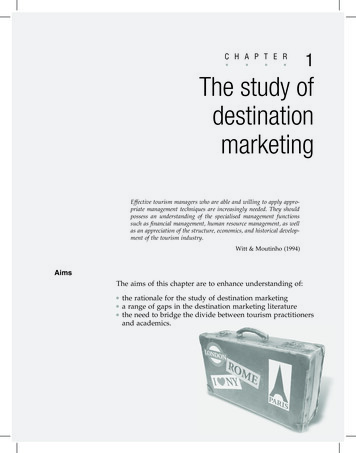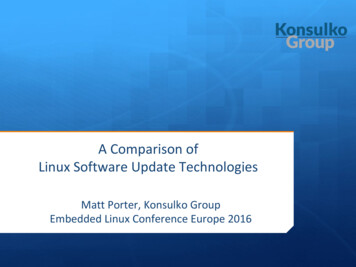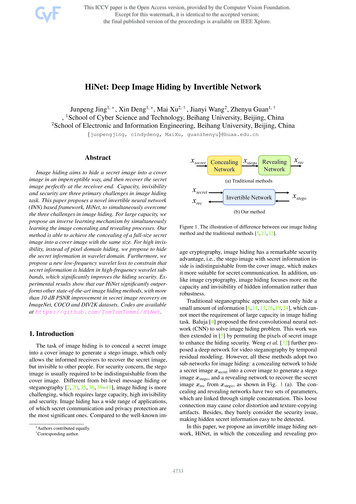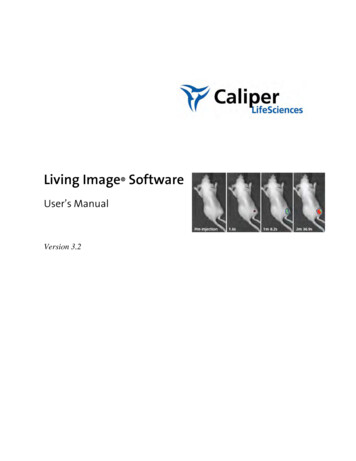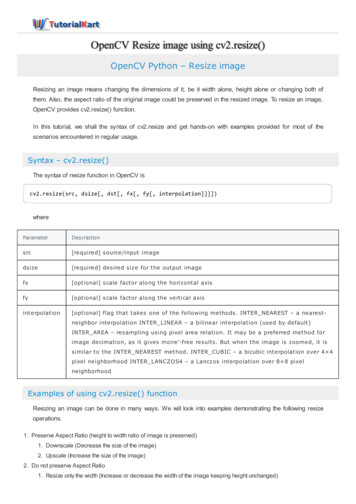
Transcription
Södertörn University School of Business StudiesMaster’s Dissertation 30 ECTS Spring Semester 2011Destination image and itseffects on marketing andbranding a touristdestinationA case study about theAustrian National Tourist Office with a focus on the market SwedenStudent: Katharina SonnleitnerSupervisor: Dr. Anders Steene
STATUTORY DECLARATION“I declare in lieu of an oath that I have written this Master thesis myself and that I havenot used any sources or resources other than stated for its preparation.I further declare that I have clearly indicated all direct and indirect quotations.This Master thesis has not been submitted elsewhere for examination purposes.”Date: June 8th 2011Signature
ACKNOWLEDGEMENTSFirst of all, I would like to express my utmost gratitude to my supervisor, Professor Dr.Anders Steene, for his support throughout this work. I am thankful for many helpfulpersonal conversations and e-mail discussions, and especially for his patience. Hisguidance and encouragement have been of great value for me and his constructivecomments provided a good basis for this Master thesis.I am also grateful for the support of the interviewed experts. Their wide knowledge andexpertise have been very helpful for the compilation of this study.Above all, I owe my loving thanks to my family, who has unremittingly supported methroughout my years of study. Without my parents’ encouragement and financial aid Iwould not have been able to pursue a university degree and achieve so much until now. Ithank for their and my brother’s endless love, patience, and understanding. I am especiallythankful for their loving support and cheer-ups during our regular phone conversationsbetween my place of study Sweden and my home country Austria!Katharina Sonnleitner
Destination image and its effects on marketing and branding a tourist destinationTABLE OF CONTENTSLIST OF TABLES AND FIGURES . 6LIST OF ABBREVIATIONS . 7ABSTRACT. 8PART A – BACKGROUND . 91BACKGROUND . 101.1 Problem statement. 101.2 Research questions and aim . 101.3 Research method . 111.3.1 Literature review . 111.3.2 Case study . 121.3.3 Advantages and disadvantages of the chosen methods . 131.3.4 Validity and reliability . 141.4 Outline of the dissertation . 15PART B – THEORETICAL FRAMEWORK . 172DESTINATION IMAGE . 182.1 Definition . 182.1.1 Primary versus secondary image . 192.1.2 Pre-visit versus post-visit image . 192.1.3 Cognitive versus affective image . 202.1.4 Attribute-based versus holistic image . 202.1 The dimensions of destination image . 212.2 Destination image formation . 232.2.1 Image formation agents . 252.2.1.1 Personal factors . 252.2.1.2 Information sources . 262.3 Destination image measurement . 272.3.1 Different techniques . 272.3.1.1 Quantitative and structured . 272.3.1.2 Qualitative and unstructured . 282.4 Country- and culture-related influences . 302.4.1 The country of origin effect . 302.4.2 The relationship of product country image and tourist destination image . 302.5 Effects of image on destination choice and consumer behaviour . 322.6 The functional relationships of destination image . 332.7 Strategic image management . 343DESTINATION MARKETING . 353.1 An overview of destination marketing. 353.1.1 Critical success factors for destination marketing . 36Katharina Sonnleitner4
Destination image and its effects on marketing and branding a tourist destination3.1.2 The need for collaboration and integration . 373.1.3 Future issues in destination marketing – the 15 Cs framework . 383.2 Destination branding . 393.2.1 Branding in general . 393.2.2 The meaning and advantages of destination branding . 403.2.3 Challenges for destination branding . 423.3 Integrating destination image and marketing. 433.3.1 The interrelationship between the two concepts . 433.3.2 The DMO’s role in conveying image . 443.3.3 The relation between image and branding . 453.4 “One size fits all” – does it really? . 47PART C – EMPIRICAL FINDINGS . 484AUSTRIAN NATIONAL TOURIST OFFICE . 494.1 Tourism in Austria and the responsible tourism organisation . 494.2 Aims and tasks of the ANTO . 504.2.1 Vision . 504.2.2 Mission. 514.3 Cultivated markets . 514.4 Tourism research activities . 524.5 Image-related studies and Austria’s destination image . 534.5.1 Country-specific studies . 534.5.2 T-MONA studies . 544.6 The brand “Urlaub in Österreich” . 564.6.1 Sub-stories . 564.6.2 Fields of fascination . 574.6.3 From brand concept to brand experience . 574.7 Transnational target group . 594.8 Market Sweden . 614.8.1 Importance for Austrian tourism. 614.8.2 The Swedish ANTO office . 624.8.3 The particularities of the Swedish market . 624.8.4 Austria’s image in Sweden . 6355.15.25.35.4DISCUSSION & CONCLUSION . 64Knowledge contribution . 64Answers to the research questions . 64Personal reflection . 67Limitations and further research . 68LIST OF REFERENCES . 70APPENDIX . 75Katharina Sonnleitner5
Destination image and its effects on marketing and branding a tourist destinationLIST OF TABLES AND FIGURESFigure 1.Common attributes in TDI research.21Figure 2.The components of destination image.22Figure 3.Stage-theory of destination image formation.24Figure 4.Image formation agents.25Figure 5.A model of destination image and its relationships.33Table 1.Critical success factors for destination marketing.36Figure 6.Brand identity, brand positioning and brand image.40Figure 7.Destination image and tourist self-image.45Figure 8.The link between destination brand and image.46Figure 9.Overview of the ANTO’s markets.51Figure 10.Austria’s summer destination image.55Figure 11.Austria’s winter destination image.55Table 2.From brand concept to brand experience.58Figure 12.Bookmark “It’s got to be Austria”.59Katharina Sonnleitner6
Destination image and its effects on marketing and branding a tourist destinationLIST OF ABBREVIATIONSANTOAustrian National Tourist OfficeCEECentral and Eastern EuropeCSFCritical Success FactorDMODestination Marketing/ Management OrganisationGMPIGlobal Market Performance IndexIMMInternational Market ManagementNTONational Tourist OrganisationÖWÖsterreich WerbungPCIProduct Country ImagePRPublic RelationsTDITourist Destination ImageT-MONATourismus Monitor AustriaUNWTOUnited Nations World Tourism OrganisationWOMWord of MouthKatharina Sonnleitner7
Destination image and its effects on marketing and branding a tourist destinationABSTRACTIn a tourism context, the image potential customers have of a destination is a veryimportant issue. Images play an essential role in destination choice matters and in thisregard, as tourism services are intangible, images are said to become even more importantthan reality.The concepts of destination image and destination marketing and branding are closelyinterrelated. The ultimate goal of any destination is to influence possible tourists’ travelrelated decision making and choice through marketing activities. Although it is notpossible to influence all aspects of image formation, tourism marketers try to strategicallyestablish, reinforce and, if necessary, change the image of their destination bycommunicating a strong destination brand. Hence, image studies are considered to be avital part of marketing and branding strategies. However, not everyone has the same imageof a destination, as image perception changes according to different influences, such aspersonal, cultural and psychological ones.The purpose of this thesis was primarily to give an overview of destination image theoryand its interrelationships to destination marketing and branding. In this respect, the studyaimed at finding out in how far a DMO can achieve to develop a marketing strategy that isconsistent and somewhat standardised, and yet adapted to the individual market and culturein which it is operated. Furthermore, the study wanted to investigate whether marketingapproaches should be changed for people with different images of a country as adestination, or if alternatively a “one-size-fits-all” approach should be employed.In addition to a literature review, a case study made it possible to show how a realorganisation handles those questions. The case of the Austrian National Tourist OfficeANTO provides a good example of an internationally operating destination marketingorganisation that uses market research, and among others also image studies, to adapt itsmarketing mix and branding approach to the individual markets’ characteristics and theimage held of the destination Austria. By means of applying the qualitative method ofpersonal in-depth interviews and thorough analysis, interesting data concerning the topic ofdestination image and marketing could be collected and compared to the findings fromliterature.Results indicate that destination image studies are the foundation of successful marketingstrategies and that in times of ever-increasing competitiveness, image is one of the fewpoints of differentiation from other tourist destinations. It is necessary to be aware of thefact that customers’ cultural differences have an influence on how different they perceiveimages. Therefore, DMOs should have a powerful overall strategy which globally leadsinto one pre-defined direction, but then locally adapt this common strategy to regionallydiffering cultural specifics. Even though destination brands should be strong andconsistent, it is not advisable to communicate the exact same image to all customers.Katharina Sonnleitner8
Destination image and its effects on marketing and branding a tourist destinationPART ABACKGROUNDKatharina Sonnleitner9
Destination image and its effects on marketing and branding a tourist destination1 BACKGROUND1.1Problem statement“As tourism services are intangible, images become more important than reality” (Govers& Go, 2007). This quote perhaps constitutes the most predicative statement building theunderlying problem of this thesis. It describes today’s situation in the tourism industry tothe point, where events and trends are becoming ever more complex and fast-paced. Astourism destination products and services cannot be tested prior to the purchase, consumershave to build images of them and make their purchase decision based on these images.Whether the image is an accurate portrayal of what the respective destination is really likeis thereby not so important, what really matters is the mere existence of the image in theminds of potential consumers (Mayo, 1975, p. 15).Images play an essential role in destination choice matters, and the ultimate goal of anydestination is to influence possible tourists’ travel-related decision making and choicethrough marketing activities. Although not all elements contributing to the development ofan image can be controlled, tourism marketers want to strategically establish, reinforceand, if necessary, change the image of their destination (Chi & Qu, 2008, p. 634).Through advertising, image can become an artificially created differentiation, because itstrongly influences and forms beliefs about the offered tourism products (MacKay &Fesenmaier, 1997, p. 540). Moreover, destination image contributes to forming adestination brand and also to its success. The starting point for developing and keeping astrong brand image is the fundamental understanding of the tourists’ images of thedestination and image studies are a prerequisite to an overall successful marketing strategy.Hence, it is clear that image is strongly related to tourism marketing issues and plays anincredibly important role for the touristic success of a destination (Tasci and Gartner, 2007,p. 413).Even though there is consensus about the fact that constant destination image monitoring iscrucial for a successful market positioning, some destination management and marketingoffices (DMOs) are not yet fully aware of the importance images play for them. They haveto become aware of the high significance of strategic image management, which canamong others be achieved through tactical branding activities.1.2Research questions and aimThe proposed underlying research questions to be treated within the scope of this Masterthesis are three-fold: How are the concepts of destination image and destination marketing and brandinginterrelated?In how far can a DMO, across different markets and cultures, achieve to develop amarketing strategy that is consistent and somewhat standardised, and yet adaptedto the individual market?Should marketing approaches be changed for people with different images of acountry as a destination, or alternatively, should a “one-size-fits-all” approach beemployed in which the same image is communicated to all potential visitors?Katharina Sonnleitner10
Destination image and its effects on marketing and branding a tourist destinationTaking these research questions as a lead, the aim of this thesis can on the one hand besummarised as to provide a deep understanding of the relation between tourist destinationimage and destination marketing efforts. In this regard, the author strives to give anextensive review of image and marketing related literature. On the other hand, anotherobjective of the paper is, in addition to the knowledge gained from literature, to use a casestudy methodology to provide valuable insight for both academics and practitioners intothe process of marketing and branding a destination. The author of this thesis chose thecase of the Austrian National Tourist Office (ANTO) to identify an internationallyoperating DMO’s practical marketing approaches.This research is made under the assumption that a better understanding of the importanceof image can bring insights with regards to more effective and efficient ways of marketingfor DMOs. In addition to findings from the literature review, the ANTO case should depictapproaches and experiences applied in practice and eventually contribute to findinganswers to the underlying questions.Although it gives an overview of destination image and takes the ANTO as an example,this paper does not attempt to make an image assessment of Austria as a destination bymeasuring in any quantitative or qualitative way the tourist destination image of Austriaamong consumers.1.3Research methodIn order to obtain viable results and provide new valuable information to the academicsphere concerning the interrelationships between destination image theory and destinationmarketing, the author selected literature review and in-depth expert interviews as researchmethods for the compilation of this paper. Both these approaches belong to the disciplineof qualitative research methods, which stands in contrast to quantitative techniques. Inqualitative research, the collected information is not based on numbers and consequentialstatistical analysis and conclusions, as it is the case with quantitative methods (Veal, 2006,pp. 98-98).1.3.1Literature reviewFor this thesis primary as well as secondary data and material are used. First, a review ofappropriate literature provides insight into the respective research fields, which shouldserve as a basis for theoretic knowledge about the paper’s topic. By reviewing andcritically analysing secondary literature, the researcher’s overall understanding of the topicwas deepened. Reading diverse articles, books and studies provided information on thecurrent state of knowledge in the respective domains and the whole context, includingtheoretical concepts, main concerns and ideas, but also gaps in knowledge becameapparent. The gained knowledge was, if suitable, integrated into the thesis and contributedconsiderably to the formulation of effective, precise and manageable research questions(Finn, Elliott-White & Walton, 2000, pp. 234-235). The literature provides perceptions onthe potential challenges of the thesis’ issue, which can be used for drawing comparisons tothe practical qualitatively approached example of the tourist destination Austria. Thus, aninterplay between theoretical considerations and practical investigations is created.Katharina Sonnleitner11
Destination image and its effects on marketing and branding a tourist destination1.3.2Case studySecondly, in order to best contribute to the body of human knowledge, a case study wasconducted by collecting primary data. Case studies are a very suitable research methodoffering comprehensiveness and profundity for understanding a particular phenomenon.Through the examination of a specific instance, a general problem can thereby becomeilluminated (Budeanu, 2007, p. 50 cited following Beeton, 2005, n.p.a.). Additionally, casestudies demonstrate a high degree of flexibility and are used extensively in tourismresearch (Hudson and Ritchie, 2009, p. 222). In order to gain insight into a DMO’spractical approaches to marketing and branding in conjunction with imagery studies, thecase of the Austrian National Tourist Office was chosen to be analysed.To obtain the appropriate information, the conduction of expert interviews was identifiedas a crucial element of the research process. The aim behind the author’s decision toconduct expert interviews was to gain primary data, to fill the gap in knowledge and tobetter comprehend a DMO’s practical approach in handling marketing issues. So, inaddition to conducting a thorough review of the relevant literature, the author alsoconducted a series of face-to-face interviews with appropriate stakeholders, based on thebeforehand gathered theoretic information. In that way, the author wanted to identify andexplore the issues and strategic challenges facing those who market destinations in thefuture generally, and specifically Austria. According to Dunn (2005, p. 80), interviews arean excellent method of gaining access to information and collecting a diversity of opinionsand experiences. The following suggestions and recommendations outlined by Dunn(2005, pp. 79-105) were taken into consideration and provided a valuable basis for theconduction of the interviews:1. Select participants:In total, four informants, who were chosen purposefully on the basis of theirconsiderable knowledge about destination marketing, participated as experts in thisstudy. In detail, Ms. Teresa Lastuvka, Ms. Marion Michenthaler, Mr. MichaelScheuch and Mr. Michael Tauschmann, who all work for different departments ofthe ANTO in Vienna and Stockholm, were approached. One person provided usefulmaterial about several relevant ANTO market research findings, the other threeagreed to give an appointment for a face-to-face interview, or to answer thequestionnaire by e-mail, respectively. The researcher had the possibility to gain aninsight into the topic of destination branding by sending questions to Mr. MichaelScheuch, who is employed as division manager for brand management in the ANTOin Vienna. Furthermore, Ms. Marion Michenthaler, ANTO responsible for marketstudies, could also be gained as interview partner for this Master thesis. Finally, apersonal meeting with Mr. Michael Tauschmann, the manager for the Swedishmarket, working in the ANTO office situated in Stockholm, could be arranged andallowed for deeper insights into the marketing activities in the Swedish market. Allthree interviews were conducted in the author’s and respondents’ mother tongueGerman for reasons of better fluency. Transcriptions of the original German versionsof the interviews, as well as translated English versions can be found in the attachedappendix of this paper.Katharina Sonnleitner12
Destination image and its effects on marketing and branding a tourist destination2. Construct the survey:The instruments utilised for the expert interviews were questionnaires, consisting ofbetween 10 and 20 questions, each individually adapted to the field of expertise ofthe respective interview partners. The research topics covered in the questionnaireswere the result of thorough literature review and considerations about how the gainedtheoretical knowledge could be combined with practical approaches.3. Collect the data:The one interview that was conducted personally was semi-structured, which meansthat the questionnaire was mainly employed as an interview guideline and althoughthe whole content of the questionnaire was covered, flexibility during the interviewwas ensured. The interview took place on April 26, 2011. It was audio taped, which,referring to Dunn (2005, p. 95), allows for a natural conversational interview. As theother two questionnaires were answered by e-mail, there was no possibility for theauthor to dig deeper by asking further questions, however, the respondents providedvery comprehensible answers and there was no lack of clarity.4. Analyse the data:After the collection of all opinions and the interview transcription, the results andfindings were compared to the underlying theoretical knowledge as well as to eachother. The analysis of the findings is integrated as basis for critical observation in thechapter about the ANTO case as well as in the paper’s conclusion.1.3.3Advantages and disadvantages of the chosen methodsThe benefits of literature review have already shortly been outlined above and includedeepening the researcher’s knowledge of the topic at hand as well as serving as a basis forthe development of a suitable research protocol. Additionally, a thorough literature reviewcan facilitate to place the study in the context of existing research. However, one majorconcern the researcher should be cautious about, is the risk of confirmation error. In otherwords, when it comes to interpreting the own case study findings in light of other existingmodels from the literature, one should be aware of and open for the possibility that thefindings contradict each other (Smith, 2010, pp. 193-194).Regarding the virtue of expert interviews, it can be found that even though qualitativeresearch is often criticised to lack credibility and rigour (Decrop, 1999, p. 158), itundoubtedly has some benefits. First of all, Walle (1997, p. 535) argues that due to the factthat qualitative research is free to ask questions, it may be possible to examine reality in allits complexity, which may not be the case with quantitative research. Consequently, it mayprovide a deeper understanding of the research area. However, Dunn (2005, p. 83) is awareof the disadvantages and reminds that carrying out expert interviews may be very timeconsuming, as the formulation of the questions and the definition of the specific topics tobe covered within the interview have to be carefully planned and prepared. Anotherpotential negative aspect is that human beings are very complex and thus, the researchermight have difficulties to correctly interpret the behaviour of the interviewees (Jamal andHollinshead, 2001, p. 71).Katharina Sonnleitner13
Destination image and its effects on marketing and branding a tourist destinationGenerally, case studies use a wide variety of different sources. The data sources for thisthesis consisted of the already mentioned personal interviews with key informants, but alsoof in-house documents, company-specific studies carried out by and received from theANTO and the organisational website. Smith (2010, p. 194) p
ANTO provides example of an internationally operating destination marketing a good organisation that uses market research, and among others also image studies, to adapt its marketing mix and branding approach to the individual markets' characteristics and the image held of the destination Austria. By means of applying the qualitative method of





